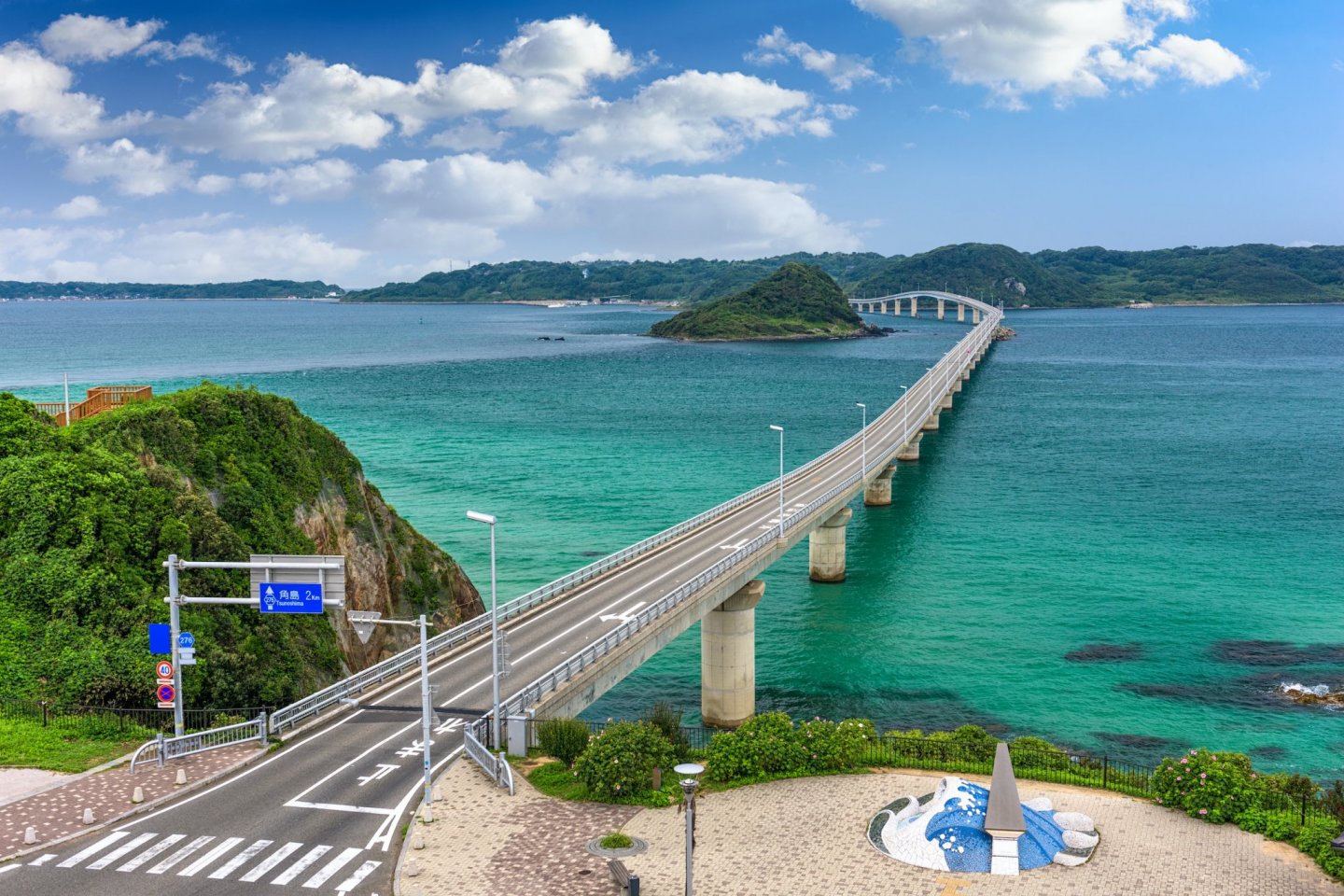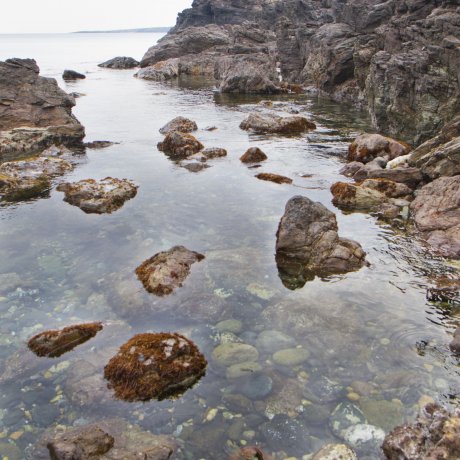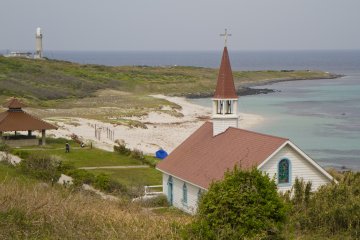

Things to do in Tsunoshima
About Tsunoshima
At the entrance to the mile-long, toll-free access bridge, stop for a moment at Sesaki Akari Park, which has a small parking lot on the mainland side with restrooms and a nice view, head over the water past tiny Hato Island to Tsunoshima. Continue on the main road for a few minutes and you’ll come across Shiokaze no Sato, a large parking lot serving a stretch of beach and a visitor’s area with orientation information, food and restrooms. Cobalt Blue Beach has shower facilities, swimming, and surfing. Bike rentals are available here from the adjacent Tsunoshima Cycle Port.
From the parking lot it’s a jaunt to the southwest to find a quiet fishing village and marina. There aren’t really any “attractions” here, but it’s worth a drive, walk, or a bicycle ride through the narrow streets and among the houses, fishing vessels, and docks. There is also a second beach on this south side of the island, just opposite Cobalt Blue Beach.
Nearby is one of the island’s main draws, the lighthouse, illuminated in 1876 by Richard Henry Brunton, the “Father of Japanese lighthouses.” The vicinity also has some restaurants, a small grassy area called Yumesakinami Park, and Yumegasaki Cape with its rocky beach and nice views.
Just east of the lighthouse, and on the opposite coast of the island from the fishing village, you’ll find the largest beach and Tsunoshima Ohama Campground. This sandy beach is fairly white with clear water and a stunning seascape. There are also some interesting rock formations along the coastline that are worth walking out to visit. Next to the campground is a building that appears to be a pretty little church, but is actually an empty leftover from the set of Miracle in Four Days, a 2005 film. You can see why they filmed here, as the views are fantastic. Near the “church” is also a small nature center as well as a peaceful graveyard hidden behind the tall grasses.
On the other end of the island, past some residential areas and farms, all the way at one of the “horns” is Makizaki Wind Park. Aptly named, the landscape is rocky coast with windswept scrub brush and grasses. There are some brilliant plants here and seasonal wildflowers. The waves are also a show in and of themselves, with whitecaps dancing toward the shore. The west side of this cape is a fine place to sit on the rocks and watch the sun set.
Other than a large resort near the bridge on the mainland and the camping area, accommodations are slim. There are also no restaurants outside of the lighthouse area or Shiokaze no Sato (and none are open late) and no convenience stores, so you might want to pack a picnic lunch or dinner.
角島大橋—tsunoshima oohashi—Tsunoshima Bridge しおかぜの里角島—shiokaze no sato tsunoshima—Shiokaze no Sato 角島灯台公園—tsunoshima toudai kouen—Tsunoshima Lighthouse Park 角島大浜海水浴場・キャンプ場—tsunoshima oohama kaisuiyokujou, kyanpujou—Tsunoshima Ohama Beach and Campground 「四日間の奇蹟」—yokkakan no kiseki—Miracle in Four Days 牧崎風の公園—makizaki kaze no kouen—Makizaki Wind Park
MoreYamaguchi Top 10
-
![Hagi City Food Guide: Best Local Eats Hagi City Food Guide: Best Local Eats]() 1
1Hagi City Food Guide: Best Local Eats
Yamaguchi -
![Explore Rarely Seen Caves at Akiyoshido Explore Rarely Seen Caves at Akiyoshido]() 2
2Explore Rarely Seen Caves at Akiyoshido
Yamaguchi -
![Cultural Exploration in Hofu City Cultural Exploration in Hofu City]() 3
3Cultural Exploration in Hofu City
Yamaguchi -
![11 Things to Do Hagi City 11 Things to Do Hagi City]() 4
411 Things to Do Hagi City
Yamaguchi -
![The Road to Hagi Yaki The Road to Hagi Yaki]() 5
5The Road to Hagi Yaki
Yamaguchi -
![Sakura Season at Yamaguchi's Tokiwa Park Sakura Season at Yamaguchi's Tokiwa Park]() 6
6Sakura Season at Yamaguchi's Tokiwa Park
Yamaguchi -
![Hagi: the Perfect Place for a 2-Day Date Hagi: the Perfect Place for a 2-Day Date]() 7
7Hagi: the Perfect Place for a 2-Day Date
Yamaguchi -
![Yamaguchi Makes NY Times 2024 Travel List Yamaguchi Makes NY Times 2024 Travel List]() 8
8Yamaguchi Makes NY Times 2024 Travel List
Yamaguchi -
![Hagi: Home of Samurai and Pottery Hagi: Home of Samurai and Pottery]() 9
9Hagi: Home of Samurai and Pottery
Yamaguchi -
![Explore Hagi City's Historical Downtown Area Explore Hagi City's Historical Downtown Area]() 10
10Explore Hagi City's Historical Downtown Area
Yamaguchi
-
![Kintaikyo Festival Kintaikyo Festival]() 1
1Kintaikyo Festival
Yamaguchi -
![Ganryujima Ganryujima]() 2
2Ganryujima
Yamaguchi -
![Iwakuni Airbase Friendship Day Iwakuni Airbase Friendship Day]() 3
3Iwakuni Airbase Friendship Day
Yamaguchi -
![Kintaikyo Cherry Blossoms Kintaikyo Cherry Blossoms]() 4
4Kintaikyo Cherry Blossoms
Yamaguchi -
![Yamaguchi Tanabata Lantern Festival Yamaguchi Tanabata Lantern Festival]() 5
5Yamaguchi Tanabata Lantern Festival
Yamaguchi -
![Kintaikyo Fireworks Festival Kintaikyo Fireworks Festival]() 6
6Kintaikyo Fireworks Festival
Yamaguchi -
![Yanai Goldfish Lantern Festival Yanai Goldfish Lantern Festival]() 7
7Yanai Goldfish Lantern Festival
Yamaguchi -
![Yamaguchi Makes NY Times 2024 Travel List Yamaguchi Makes NY Times 2024 Travel List]() 8
8Yamaguchi Makes NY Times 2024 Travel List
Yamaguchi -
![Amidaji Temple Hydrangea Festival Amidaji Temple Hydrangea Festival]() 9
9Amidaji Temple Hydrangea Festival
Yamaguchi -
![Hagi Summer Citrus Festival Hagi Summer Citrus Festival]() 10
10Hagi Summer Citrus Festival
Yamaguchi
-
![Cultural Exploration in Hofu City Cultural Exploration in Hofu City]() 1
1Cultural Exploration in Hofu City
Yamaguchi -
![Explore Rarely Seen Caves at Akiyoshido Explore Rarely Seen Caves at Akiyoshido]() 2
2Explore Rarely Seen Caves at Akiyoshido
Yamaguchi -
![Explore Hagi City's Historical Downtown Area Explore Hagi City's Historical Downtown Area]() 3
3Explore Hagi City's Historical Downtown Area
Yamaguchi -
![Hagi City Food Guide: Best Local Eats Hagi City Food Guide: Best Local Eats]() 4
4Hagi City Food Guide: Best Local Eats
Yamaguchi -
![11 Things to Do Hagi City 11 Things to Do Hagi City]() 5
511 Things to Do Hagi City
Yamaguchi -
![Sakura Season at Yamaguchi's Tokiwa Park Sakura Season at Yamaguchi's Tokiwa Park]() 6
6Sakura Season at Yamaguchi's Tokiwa Park
Yamaguchi -
![The Road to Hagi Yaki The Road to Hagi Yaki]() 7
7The Road to Hagi Yaki
Yamaguchi -
![Hagi: the Perfect Place for a 2-Day Date Hagi: the Perfect Place for a 2-Day Date]() 8
8Hagi: the Perfect Place for a 2-Day Date
Yamaguchi -
![Hagi Has It All Hagi Has It All]() 9
9Hagi Has It All
Yamaguchi -
![Azaleas at Mount Ohira Azaleas at Mount Ohira]() 10
10Azaleas at Mount Ohira
Yamaguchi
Places to stay in Tsunoshima

Latest Tsunoshima Reports
 20
20
A Solid-Rock Nature Walk
Tristan ScholzeA photographic nature tour of the rocky shores near Ohama Campground on Tsunoshima in Yamaguchi.
 6
6
Tsunoshima Lighthouse
Tristan ScholzeTsunoshima Lighthouse dates from 1876 and watches over a sculpted park, rocky cape, and a few restaurants.
About Tsunoshima
Just off the northern Yamaguchi coast in the Sea of Japan lies Tsunoshima, a small but attractive island. Easily accessible now due to the Tsunoshima Bridge, the island’s sculpted landscapes, parks, quaint fishing villages, beaches, campground, and lighthouse make for an enjoyable weekend getaway. The rural retreat, part of Kita-Nagato Kaigan Quasi-National Park, has a population of about a thousand and covers 4.1 square kilometers (1.6 sq mi). Tsuno means “horn” in Japanese, and with some imagination you might see horns in the island’s shape as viewed from above.
At the entrance to the mile-long, toll-free access bridge, stop for a moment at Sesaki Akari Park, which has a small parking lot on the mainland side with restrooms and a nice view, head over the water past tiny Hato Island to Tsunoshima. Continue on the main road for a few minutes and you’ll come across Shiokaze no Sato, a large parking lot serving a stretch of beach and a visitor’s area with orientation information, food and restrooms. Cobalt Blue Beach has shower facilities, swimming, and surfing. Bike rentals are available here from the adjacent Tsunoshima Cycle Port.
From the parking lot it’s a jaunt to the southwest to find a quiet fishing village and marina. There aren’t really any “attractions” here, but it’s worth a drive, walk, or a bicycle ride through the narrow streets and among the houses, fishing vessels, and docks. There is also a second beach on this south side of the island, just opposite Cobalt Blue Beach.
Nearby is one of the island’s main draws, the lighthouse, illuminated in 1876 by Richard Henry Brunton, the “Father of Japanese lighthouses.” The vicinity also has some restaurants, a small grassy area called Yumesakinami Park, and Yumegasaki Cape with its rocky beach and nice views.
Just east of the lighthouse, and on the opposite coast of the island from the fishing village, you’ll find the largest beach and Tsunoshima Ohama Campground. This sandy beach is fairly white with clear water and a stunning seascape. There are also some interesting rock formations along the coastline that are worth walking out to visit. Next to the campground is a building that appears to be a pretty little church, but is actually an empty leftover from the set of Miracle in Four Days, a 2005 film. You can see why they filmed here, as the views are fantastic. Near the “church” is also a small nature center as well as a peaceful graveyard hidden behind the tall grasses.
On the other end of the island, past some residential areas and farms, all the way at one of the “horns” is Makizaki Wind Park. Aptly named, the landscape is rocky coast with windswept scrub brush and grasses. There are some brilliant plants here and seasonal wildflowers. The waves are also a show in and of themselves, with whitecaps dancing toward the shore. The west side of this cape is a fine place to sit on the rocks and watch the sun set.
Other than a large resort near the bridge on the mainland and the camping area, accommodations are slim. There are also no restaurants outside of the lighthouse area or Shiokaze no Sato (and none are open late) and no convenience stores, so you might want to pack a picnic lunch or dinner.
角島大橋—tsunoshima oohashi—Tsunoshima Bridge しおかぜの里角島—shiokaze no sato tsunoshima—Shiokaze no Sato 角島灯台公園—tsunoshima toudai kouen—Tsunoshima Lighthouse Park 角島大浜海水浴場・キャンプ場—tsunoshima oohama kaisuiyokujou, kyanpujou—Tsunoshima Ohama Beach and Campground 「四日間の奇蹟」—yokkakan no kiseki—Miracle in Four Days 牧崎風の公園—makizaki kaze no kouen—Makizaki Wind Park























